The past 12 months have been significant for two renewable energy technologies in particular: solar PV and anaerobic digestion (AD).
However, when we talk about these technologies, there are often two very different scales—large-scale and small-scale— each with distinct business models and opportunities for farmers.
This was the topic of conversation during a talk at the Irish Farmers Journal stand at the National Ploughing Championships this year, where we were joined by four experts to discuss each model and how they can work for farmers.
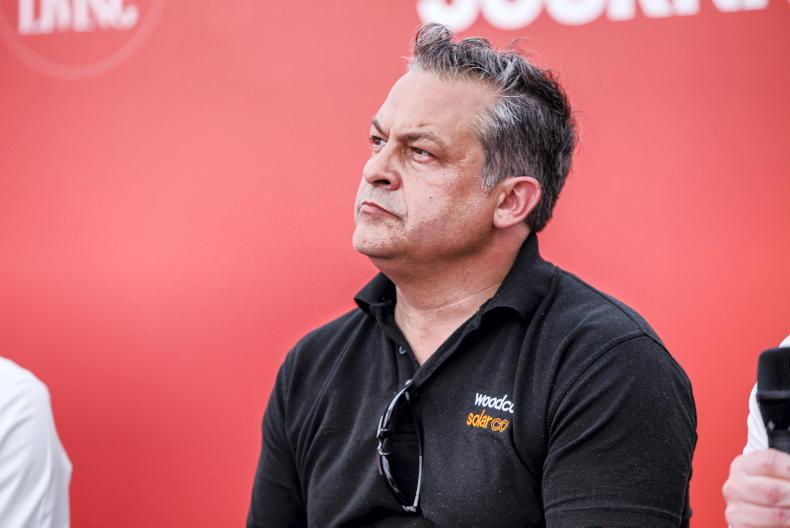
Gerard Kennedy.
Small-scale solar
Gerard Kennedy, Commercial Sales Manager with Solarco, explained that grant aid and economics are the main drivers of solar PV investments on farms at the moment. He said these two elements combined are reducing the payback period on investments from seven years to two-to-three years in many cases. He stated that the most progressive sectors in solar PV, based on their experience, have been mushroom and pig producers and, to a lesser extent, poultry. However, he felt that solar adoption has yet to fully unfold in the other agricultural sectors.
During the panel discussion, he presented an example of a large, 620 kilowatt peak (kWp) solar PV system on a mushroom producer’s farm, which was providing 18% to 20% of their demand (pictured bottom right). Gerard explained that most of the power generated from the system will be produced from April to October, and it’s a balance between sizing the system to demand requirements.
While you can export surplus power to the grid, the payment you’ll likely receive will be small, he said. The import capacity for the farm is also a significant limiting factor for the system size you can install, he explained.
Running through an example, he explained that a 22kWp solar PV system and a 10kWh battery on a 160-cow dairy farm would cost around €33,000. With energy savings of around €6,000 per year, combined with a 60% grant, the payback period would be about two and a half years.
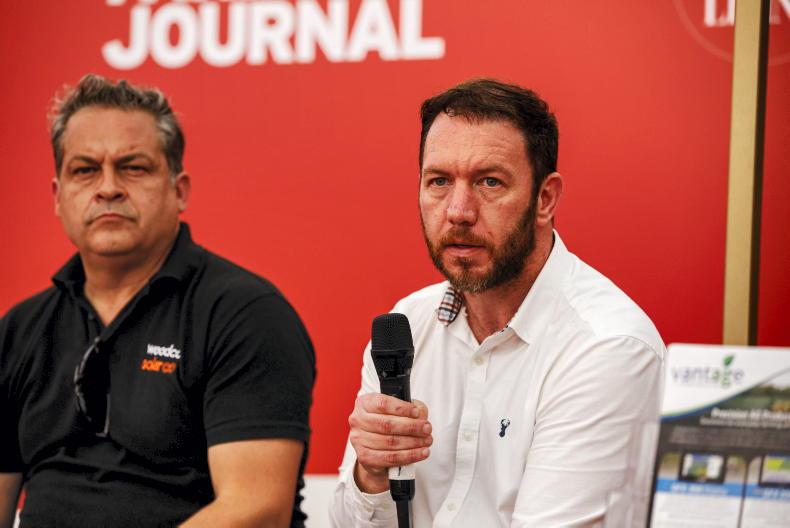
James Redmond.
Solar farms
James Redmond, (inset below) Head of Development for Ireland at BayWa r.e, explained that the demanding 2030 Climate Action Plan targets are the chief drivers of solar farm expansion in Ireland. Unlike rooftop solar, where most of the energy generated is used on-site, with solar farms, all of the electricity is exported to the national grid.
He explained that each megawatt of solar would require around 2.5 acres. A typical 3MW solar farm will produce enough power for around 1,000 homes.
Most farmers who allow solar to be developed on their land will receive an annual rental income ranging from €1,100-€1,250 per acre for around 35 years, he said.
When asked if the farmland is taken completely out of action when under panels, James said, “that comes down to the farmer’s choice. We see that some farmers just want to shut the gate and not worry about it, and we see others who like to do maintenance, so we offer maintenance contracts with them and they can graze sheep,” he said. “They get paid for doing that,” said James.
When asked about the use of good farmland for solar, he said that across their portfolio, many of their projects are not developed on prime agricultural land, and that it isn’t necessarily a requirement. Pictured on the bottom left is the first solar farm project by BayWa r.e in Northern Ireland.
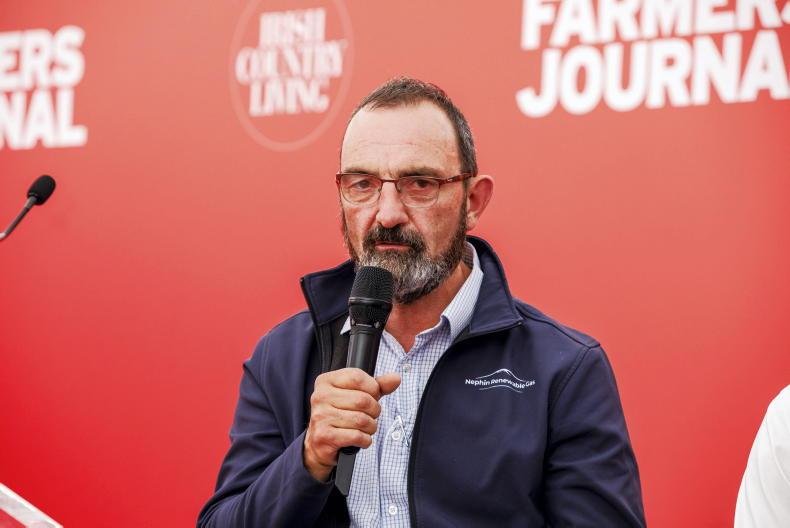
Michael Sweeney.
Large-scale
commercial AD
Michael Sweeney, (inset above) operations director of Nephin Renewable Gas, explained to the audience that their aim is to have at least 20 large-scale AD plants built and operational by 2030, pumping renewable biomethane gas into the gas grid.
He stated that their approach is to develop agri-centric AD plants, using a similar feedstock mixes consisting of manures, food processing waste and crops. The company has developed a standardised AD model, which they believe will deliver a sustainable business going forward.
The model will produce 60 gigawatt-hours of biomethane and will be fed with 30,000 tonnes of slurries, 30,000 tonnes of agricultural and distillery byproducts such as pot ale and dairy sludges, and 30,000 tonnes of crops.
These large-scale projects, costing €25-30 million to build, will offer a new market for slurries to farmers in the area, as well as a steady supply of digestate that has been processed through a nutrient recovery system. Michael explained that after solid separation, clean water will be extracted from the digestate and discharged.
Each plant will require 2,000-3,000 acres of crops, which will be supplied through feedstock contracts with local farmers. Michael mentioned that they prefer wholecrops, such as a winter oats and pea/bean mixes over grass silage.
Wholecropping enable crops to be harvested early, allowing for the early establishment of cover crops and the application of digestate.
Michael also provided an example of one of their first new AD projects in the planning system in Mayo, which is situated on a 9.7 acre site.
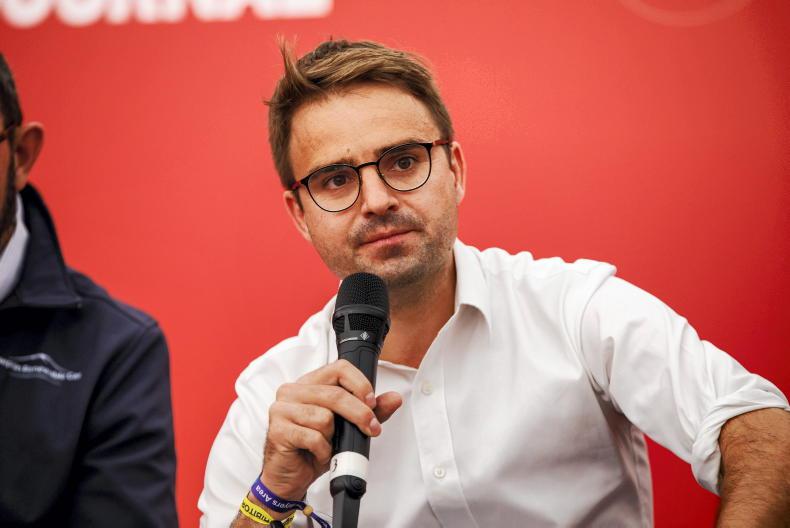
Klaas Venhee.
Small-scale AD
While Michael described their Irish large-scale AD model, Klaas Vanhee, Commercial Director with Biolectric, gave the audience an insight into small-scale AD plants. Based in Belgium, Biolectric supplies turnkey, small-scale AD plants for farms. They are currently installing two per week across Europe.
Klaas explained that their AD plant is designed to be part of a working farmyard. Most of their current AD plants produce electricity, but they have a number of models that produce biomethane. Electricity-producing AD plants will work on farms with around 100 cows, while a herd size of around 400 cows is needed for biomethane plants.
Fresh slurry from the farm is pumped directly into the AD plant. When asked if the cows need to be indoors full-time for the system to work, he said that they do have AD plants installed on dairy farms where cows graze outdoors. In practice, many farmers use other feedstocks in the AD plant as well as manure.
The AD plant tanks are small compared to Nephin’s plants, ranging from 200 cubic meters to 1,850 cubic meters in size.
Klaas provided an example of a 110-cow dairy farm supplying slurry to a Biolectric AD plant with a 22kW electrical generator producing around 150MWh of electricity per year. “As you see, the plant is very small, which makes it easy to integrate into the farm, and planning is a lot easier,” Klaas said.
He mentioned that the plant is viable on farms where imported electricity costs 22c/kWh or more. He added that there is significant interest among Irish farmers in the system, as well as from the government. When asked about the cost, he said plants start from the price of a tractor, which includes a year’s maintenance.
In shortThere are opportunities for farmers from both large- and small-scale AD and solar PV.However, the value and nature of the opportunities differ greatly. Policy and economics remain key drivers of renewables investments. Listen to the podcast here.
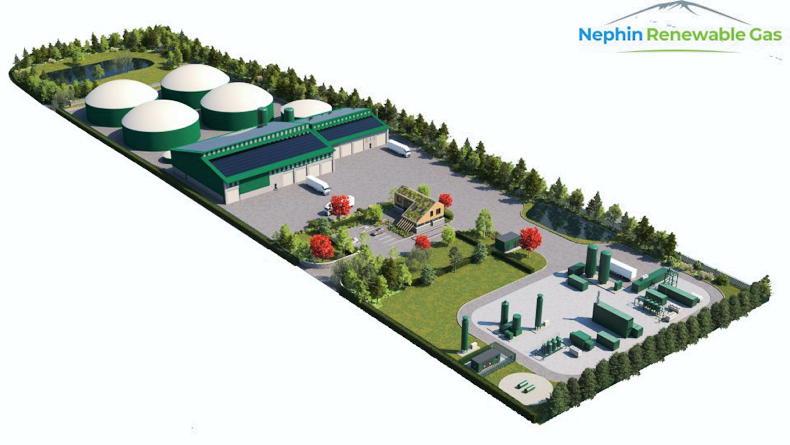
The first project by Nephin Renewable Gas in the planning system in Mayo.

Solarco's panels installed on a mushroom producer.

The first solar farm project by BayWa r.e in Northern Ireland.
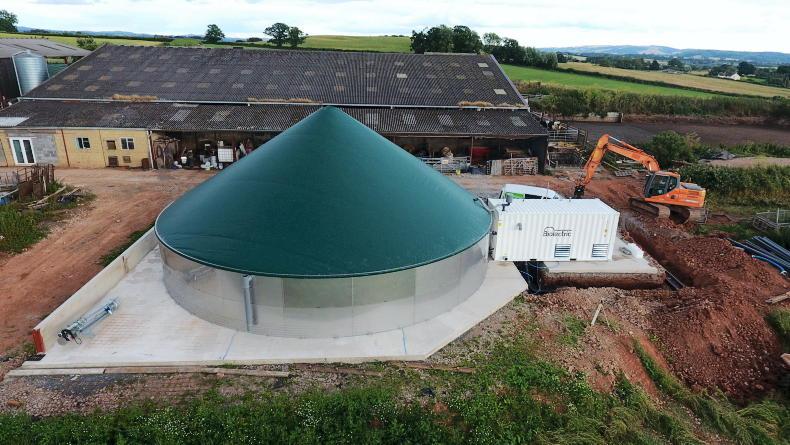
A biolectric AD plant installed on a 110-cow dairy farm.
The past 12 months have been significant for two renewable energy technologies in particular: solar PV and anaerobic digestion (AD).
However, when we talk about these technologies, there are often two very different scales—large-scale and small-scale— each with distinct business models and opportunities for farmers.
This was the topic of conversation during a talk at the Irish Farmers Journal stand at the National Ploughing Championships this year, where we were joined by four experts to discuss each model and how they can work for farmers.

Gerard Kennedy.
Small-scale solar
Gerard Kennedy, Commercial Sales Manager with Solarco, explained that grant aid and economics are the main drivers of solar PV investments on farms at the moment. He said these two elements combined are reducing the payback period on investments from seven years to two-to-three years in many cases. He stated that the most progressive sectors in solar PV, based on their experience, have been mushroom and pig producers and, to a lesser extent, poultry. However, he felt that solar adoption has yet to fully unfold in the other agricultural sectors.
During the panel discussion, he presented an example of a large, 620 kilowatt peak (kWp) solar PV system on a mushroom producer’s farm, which was providing 18% to 20% of their demand (pictured bottom right). Gerard explained that most of the power generated from the system will be produced from April to October, and it’s a balance between sizing the system to demand requirements.
While you can export surplus power to the grid, the payment you’ll likely receive will be small, he said. The import capacity for the farm is also a significant limiting factor for the system size you can install, he explained.
Running through an example, he explained that a 22kWp solar PV system and a 10kWh battery on a 160-cow dairy farm would cost around €33,000. With energy savings of around €6,000 per year, combined with a 60% grant, the payback period would be about two and a half years.

James Redmond.
Solar farms
James Redmond, (inset below) Head of Development for Ireland at BayWa r.e, explained that the demanding 2030 Climate Action Plan targets are the chief drivers of solar farm expansion in Ireland. Unlike rooftop solar, where most of the energy generated is used on-site, with solar farms, all of the electricity is exported to the national grid.
He explained that each megawatt of solar would require around 2.5 acres. A typical 3MW solar farm will produce enough power for around 1,000 homes.
Most farmers who allow solar to be developed on their land will receive an annual rental income ranging from €1,100-€1,250 per acre for around 35 years, he said.
When asked if the farmland is taken completely out of action when under panels, James said, “that comes down to the farmer’s choice. We see that some farmers just want to shut the gate and not worry about it, and we see others who like to do maintenance, so we offer maintenance contracts with them and they can graze sheep,” he said. “They get paid for doing that,” said James.
When asked about the use of good farmland for solar, he said that across their portfolio, many of their projects are not developed on prime agricultural land, and that it isn’t necessarily a requirement. Pictured on the bottom left is the first solar farm project by BayWa r.e in Northern Ireland.

Michael Sweeney.
Large-scale
commercial AD
Michael Sweeney, (inset above) operations director of Nephin Renewable Gas, explained to the audience that their aim is to have at least 20 large-scale AD plants built and operational by 2030, pumping renewable biomethane gas into the gas grid.
He stated that their approach is to develop agri-centric AD plants, using a similar feedstock mixes consisting of manures, food processing waste and crops. The company has developed a standardised AD model, which they believe will deliver a sustainable business going forward.
The model will produce 60 gigawatt-hours of biomethane and will be fed with 30,000 tonnes of slurries, 30,000 tonnes of agricultural and distillery byproducts such as pot ale and dairy sludges, and 30,000 tonnes of crops.
These large-scale projects, costing €25-30 million to build, will offer a new market for slurries to farmers in the area, as well as a steady supply of digestate that has been processed through a nutrient recovery system. Michael explained that after solid separation, clean water will be extracted from the digestate and discharged.
Each plant will require 2,000-3,000 acres of crops, which will be supplied through feedstock contracts with local farmers. Michael mentioned that they prefer wholecrops, such as a winter oats and pea/bean mixes over grass silage.
Wholecropping enable crops to be harvested early, allowing for the early establishment of cover crops and the application of digestate.
Michael also provided an example of one of their first new AD projects in the planning system in Mayo, which is situated on a 9.7 acre site.

Klaas Venhee.
Small-scale AD
While Michael described their Irish large-scale AD model, Klaas Vanhee, Commercial Director with Biolectric, gave the audience an insight into small-scale AD plants. Based in Belgium, Biolectric supplies turnkey, small-scale AD plants for farms. They are currently installing two per week across Europe.
Klaas explained that their AD plant is designed to be part of a working farmyard. Most of their current AD plants produce electricity, but they have a number of models that produce biomethane. Electricity-producing AD plants will work on farms with around 100 cows, while a herd size of around 400 cows is needed for biomethane plants.
Fresh slurry from the farm is pumped directly into the AD plant. When asked if the cows need to be indoors full-time for the system to work, he said that they do have AD plants installed on dairy farms where cows graze outdoors. In practice, many farmers use other feedstocks in the AD plant as well as manure.
The AD plant tanks are small compared to Nephin’s plants, ranging from 200 cubic meters to 1,850 cubic meters in size.
Klaas provided an example of a 110-cow dairy farm supplying slurry to a Biolectric AD plant with a 22kW electrical generator producing around 150MWh of electricity per year. “As you see, the plant is very small, which makes it easy to integrate into the farm, and planning is a lot easier,” Klaas said.
He mentioned that the plant is viable on farms where imported electricity costs 22c/kWh or more. He added that there is significant interest among Irish farmers in the system, as well as from the government. When asked about the cost, he said plants start from the price of a tractor, which includes a year’s maintenance.
In shortThere are opportunities for farmers from both large- and small-scale AD and solar PV.However, the value and nature of the opportunities differ greatly. Policy and economics remain key drivers of renewables investments. Listen to the podcast here.

The first project by Nephin Renewable Gas in the planning system in Mayo.

Solarco's panels installed on a mushroom producer.

The first solar farm project by BayWa r.e in Northern Ireland.

A biolectric AD plant installed on a 110-cow dairy farm.














 This is a subscriber-only article
This is a subscriber-only article








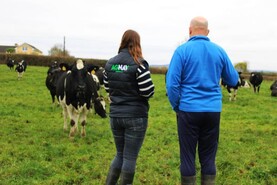

SHARING OPTIONS: